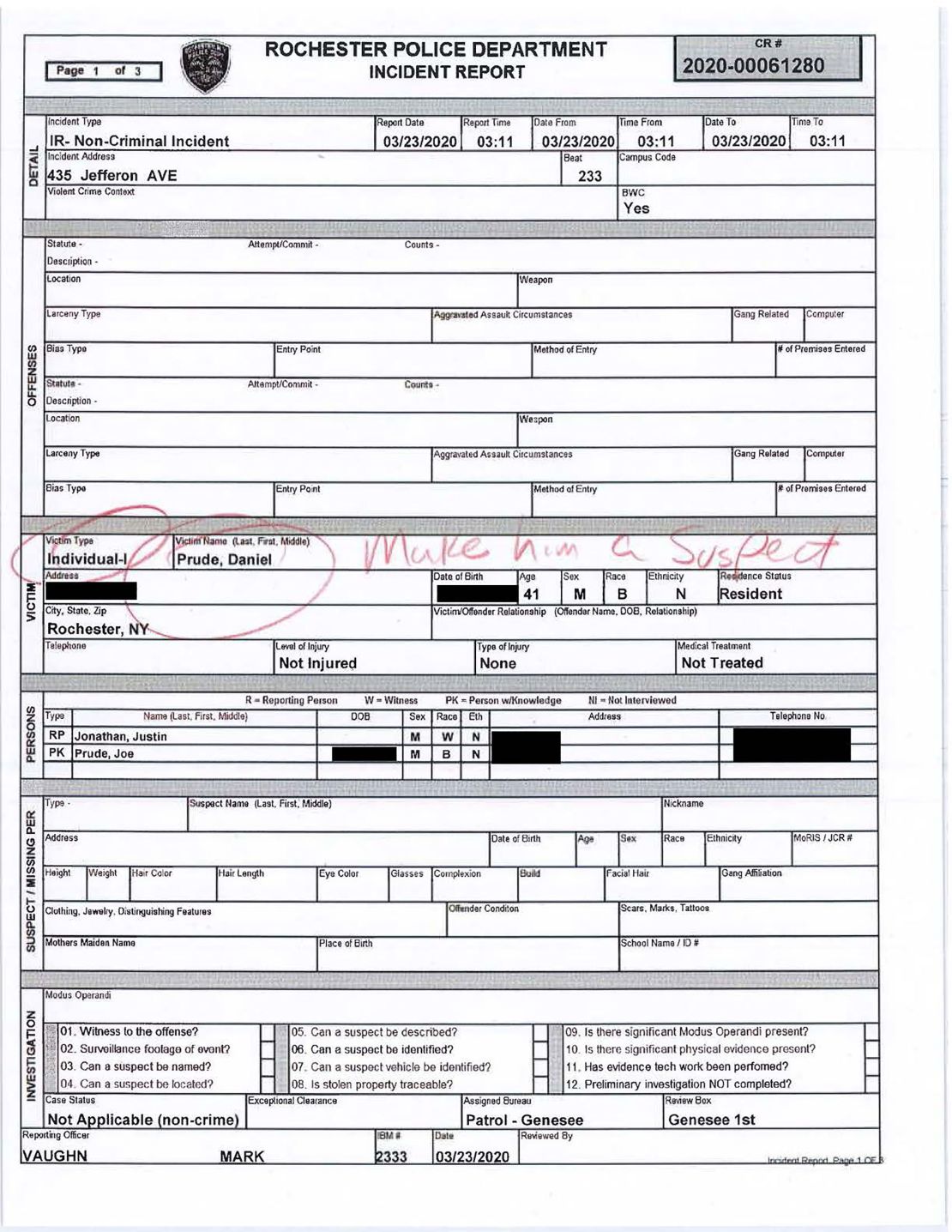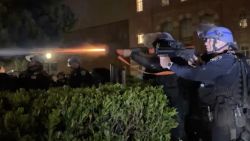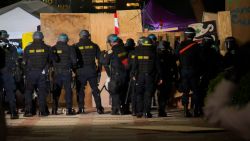The city of Rochester, New York, released 325 pages of internal emails, police reports and other documents on Monday that show a concerted effort by police and city officials to delay the release of incriminating body camera footage in the death of Daniel Prude, a Black man who died after police pinned him to the ground in March.
The documents also include other examples of possible attempts by police and city officials to control the narrative around Prude’s death in custody.
A Prude family attorney’s request for body camera footage set into motion an effort by city and police officials to slow-walk the release of the tape, which shows officers kneeling on and restraining Prude.
Elliot Shields, an attorney retained by Prude’s brother, filed a Freedom of Information Law request for the footage on April 3. The footage was not released until August 12.
In an email sent May 28 – three days after Minneapolis Police killed George Floyd – Shields wrote to the city to say he had yet to receive any response.
The documents show that, following that email, city attorneys spoke with Rochester police officials and also an attorney in New York’s Attorney General’s office in an effort to deny or delay the request.
“I’m wondering if we shouldn’t hold back on this for a little while considering what is going on around the country,” one police official wrote in an email to a city attorney on June 4. Among those involved in the conversation include then-Chief La’Ron Singletary and current acting Chief Mark Simmons.
“We certainly do not want people to misinterpret the officers’ actions and conflate this incident with any recent killings of unarmed black men by law enforcement nationally,” Simmons wrote. “I ask that we reach out to Corporation Council and ask them to deny the request based on the fact that the case is still active, as it is currently being investigated for possible criminal charges to be brought forth by the AG’s office.”
“I totally agree,” Singletary responded.
The footage, released to the public two weeks ago, shows officers handcuff a naked Prude and cover his head with a “spit sock” after he claimed he had coronavirus and was spitting. The officers hold him and push him to the ground in a prone position, the video shows.
Prude stopped breathing and was declared brain-dead at a hospital, where he died a week later, on March 30.
The Monroe County Medical Examiner ultimately ruled Prude’s death a homicide, citing complications of asphyxia in the setting of physical restraint. The report also cites excited delirium and acute PCP intoxication as contributing factors to the immediate cause of death.
Accusations of cover-up
The release of that footage to the public two weeks ago has led to protests in Rochester and accusations of a cover-up. On Monday, the same day the city released the documents, Rochester Mayor Lovely Warren pushed out the police chief ahead of his retirement and suspended two other city employees.
“This initial look has shown what so many have suspected, that we have a pervasive problem in the Rochester Police Department,” Warren said in a news release. “One that views everything through the eyes of the badge and not the citizens we serve. It shows that Mr. Prude’s death was not taken as seriously as it should have been by those who reviewed the case throughout City government at every level.”
In a statement last week announcing his retirement, Singletary said the public was misinformed about what he did.
“The members of the Rochester Police Department and the Greater Rochester Community know my reputation and know what I stand for,” Singletary said. “The mischaracterization and the politicization of the actions that I took after being informed of Mr. Prude’s death is not based on facts, and is not what I stand for.”
Last week, Prude’s sister filed suit in federal court against Singletary, 13 other officers and the upstate New York city, claiming in part a department cover-up of the death. Neither Singletary nor the city responded to requests for comment about the litigation.
Simmons, the acting chief, did not respond to CNN’s request for comment Wednesday.
New York’s Freedom of Information Law allows state agencies to withhold documents when their disclosure would interfere with an ongoing investigation or compromise a confidential informant.
Shields, the family attorney, was able to view the police footage at the Attorney General’s office in mid-July but was not provided a copy.
In a June 3 email between Rochester Police Lt. Michael Perkowski and Rochester city attorney Stephanie Price, Perkowski said that an attorney at the AG’s office “may be able to assist by allowing the plaintiff’s attorney to view the Body Worn Camera footage without releasing it, to buy some more time before we have to release this.”
On Wednesday, New York Attorney General Letitia James’s office issued CNN a statement defending her office.
“At no point over the course of this investigation did any member of the Attorney General’s Office instruct the city of Rochester or the Rochester Police Department to withhold information of any kind, period.
“For weeks, the city and the police department have engaged in a deeply troubling and misleading campaign in an attempt to cover their tracks and shirk accountability, rather than focusing on the real problem at hand. As we have done since April, our office will continue to work tirelessly and without distraction to provide the answers that the Prude family and Rochester community deserve.”
‘Make him a suspect’

Additionally, the documents show at least two instances in which changes were made to reports that related to the incident that led to Prude’s death.
Two incident reports filed by police officers appear, in the documents released by the city, to have been edited with red pencil. It is unclear who made these handwritten notes or when they were in fact made. In one incident report filed by Officer Mark Vaughn, among many edits, some prosaic, Prude’s name is written in the space labeled “Victim.”
Prude’s name is circled in red, next to a large, handwritten note: “Make him a suspect.”
A similar note is appended to a report by Officer Paul Ricotta, who responded to a burglary alarm at 3:10 a.m.
“List Daniel Prude as [Suspect],” it reads in red pencil. “Add burglary – video recorded during the day shows [suspect] break window & enter location.”
Body cam footage from Prude’s arrest include officers speculating if Prude (described as “Mr. PCP”) might be the person responsible for a broken window at a T-Mobile store. The original report had listed the suspect as “unknown.”
Rochester Police Union President Mike Mazzeo told CNN on Wednesday he doesn’t know who penned the handwritten revisions on the police reports but said it’s standard practice to make revisions to reports before they’re finalized. He pointed out that the reports in question do not have a supervisor’s sign-off on them.
An undated follow-up report on the incident from Rochester’s Major Crimes Unit states that “several reports have been rejected for revisions,” but does not clarify which reports, nor what revisions.
Attempt to speak with Medical Examiner’s office

Further, the documents reveal an email exchange following Prude’s death at Strong Memorial Hospital in which Lt. Perkowski sought to speak with the Medical Examiner’s office prior to Prude’s autopsy.
“I imagine your office will be doing the autopsy,” Perkowski wrote to Julie Luedke, the Confidential Assistant to the Monroe County Medical Examiner on March 31. “Can you and I have a conversation before you start that?”
“It is somewhat sensitive, as he was in police custody when he was sent to the hospital,” Perkowski continued. “I was on scene and have all of the details for you.”
In response, Luedke asked for the relevant incident reports, which Perkowski said were on their way. He then again said he had “background info” and offered to come meet with the Medical Examiner. Luedke responded by saying she would call Perkowski.
The Monroe County Medical Examiner ultimately ruled Prude’s death a homicide. CNN has reached out to the Medical Examiner’s office for comment.
Mazzeo, the police union president, said this was likely a standard interaction.
“A medical examiner has to have the information and set a lot of information based on the context of what occurred,” he said.
“I didn’t see any of these emails until they were released. But I’m telling you that the medical examiner always wants that type of information and major crimes works hand in hand with the ME’s office on any homicide or any investigation.”
Mazzeo said the union will provide representation for officers involved in the case, and he plans to announce the names of those attorneys as soon as Friday.
He also acknowledged the missteps among police and city leadership.
“I am shocked, and I have no reason why they handled this in that manner. And apparently the chief has paid the price for it, but I tend to believe that there’s way too many fall guys here. And we’re not really getting to the root of the problem,” he said.
“Why would any of us want to live through what we’re living through now? You know, the public’s trust is important, and it’s very difficult in police work anyways. Why make stupid mistakes or handle things this way. It makes no sense. And leadership should be called into question on this.”
CNN’s Eric Levenson contributed to this report.























